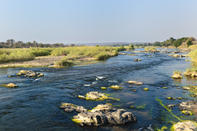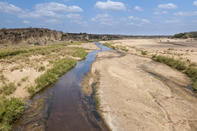Mining Town Origins
During the 1800’s, the Ba Phalaborwa Tribe settled in the area of Phalaborwa, as it is rich in metals, which they mined. They originally came from the north, found the Letaba and Olifants Rivers and iron ore and decided to settle in the lush valley area.

The Ba Phalaborwa Tribe traded iron items that they had smelted themselves, with other tribes and possibly even Arab slave traders and Portuguese. This tribe gave the present day name of Phalaborwa to the town they deemed it a good place to settle and is “better than the south”.
In 1934, the first modern day mining began, with the extraction of apatite, used as a fertiliser. But at this time the area was too remote for it to be profitable. In 1946, a South African geologist, Dr Hans Merensky, prospected the area looking for economically viable deposits of apatite in the foskorite rocks found here. In the 1950’s uranium was discovered but in such low yields not worth pursuing.
Whilst prospecting, copper was found, and in enough quantities to be viable. Rio Tinto Zinc and Newmont Mining joined to form the Palabora Mining Company in 1956. The town grew to accommodate the miners and their families. Stores opened and churches were built. In 1966, Phalaborwa saw production of copper from the largest open pit mine in the world, and the town grew even more.
The Phalaborwa Complex
The geological history of what is known as the Phalaborwa Complex goes back some 2 050 million years ago, when molten matter intruded into granite along three large and numerous smaller volcanic pipes. A variety of minerals were formed within these pipes, such as copper, phosphate, iron, baddeleyite and vermiculite.
Over countless aeons, the overlying rock was eroded away to expose the more resistant hills that punctuate the plains around Phalaborwa. Mining of the copper-rich central volcanic pipe began in 1956 and has created one of the largest man-made holes in Africa.
With a circumference of over 5 km and a diameter of nearly 1 900 m, the near-circular open pit is 762 m deep and six times the size of Kimberley's famous Big Hole. In addition to the rich copper deposits, the mine has also been a source of phosphate (used in the fertiliser industry) and magnetite, a byproduct of copper and phosphate.

A Mix of Miners and Tourism
The Phalaborwa Gate of the Kruger National Park was officially opened in 1961, adding tourism establishments and their suppliers to the mining mix of the town. Present day Phalaborwa is still populated by a mix of miners and tourism workers.
The Ba Phalaborwa Tribe still reside in the Greater Phalaborwa region, and continue with many of their traditions and way of life. Phalaborwa has not only been the gateway to the Kruger National Park but also put the city on the map. Its location and natural resources have led to the development of various industries and a prime location for tourism.